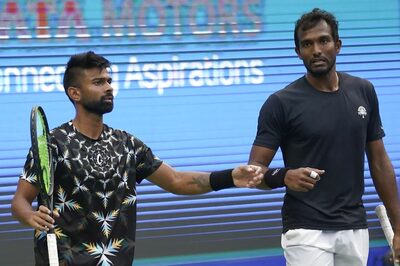
views
This article is a sequel to the poignant and frightening News18 story that Vinesh Phogat could have died in her single-minded obsession or desire (junoon or even bravado is slightly more expressive ) to enter final and win the 50 kg category wrestling gold which she could well have had she not fallen foul of the cast-in-stone weight norms — if you are entering the 50 kg weight category, you can’t be overweight on the morn of the bout even by a gram.
“After the semi-final, 2.7 kg of excess weight was left; we exercised for one hour and twenty minutes, but 1.5 kg still remained. Later, after 50 minutes of sauna, not a drop of sweat appeared on her. There was no choice left, and from midnight to 5:30 in the morning, she worked on different cardio machines and wrestling moves, about three-quarters of an hour at one go, with two-three minutes of rest. Then she started again. She collapsed, but somehow, we got her up, and she spent an hour in the sauna. I don’t intentionally write dramatic details, but I only remember thinking that she might die.”.
The above is the graphic but chilling account of her frantic overnight effort by her Hungarian coach Woller Akos is graphic. Thank God, she is alive. A similar attempt at overnight weight reduction by her compatriot Aman Sahrawat which surprisingly was successful: “Aman Sehrawat was 4.5kg overweight before the weigh-in for his bronze medal match but he managed to lose 100 grams more than needed to win another medal for India at the Paris Olympics 2024”.
The Firstpost story relating to Aman is as graphic as news18’s relating to Vinesh but is less chilling in hindsight because all is well that ends well. While this is philosophising, a plausible medical explanation is that being 8 years younger — Vinesh is 29 while Aman is just 21 — Aman had a faster metabolism or food absorption rate. Be that as it may, the bottom line is: What proved to be almost counterproductive for Vinesh turned out to be beneficial for Aman. The adage fortune favours the brave alas worked partially, was proved right in Aman’s case but counterproductive in hindsight in Vinesh’s case.
That Aman won the bronze medal after a crash weight reduction programme is amazing given the fact that sleep and food and its ingestion are absolute necessities to stay fit and alert. Horlicks height-weight chart, which lays down approximate ideal weight for Indian men and women separately, is not dogmatic but instead gives the ideal weight in a broad range. Its prefatory words quoted below are illumining: “Genetics play a significant role in determining height and weight potential, but nutrition, lifestyle, and physical activity influence how this potential is realised. A balanced diet, exercise, and healthy habits impact growth and weight management. Medical conditions or hormonal issues can also affect height and weight.”
Horlicks exhorts people to read the ideal it has worked out in juxtaposition with the BMI or body mass index. What is important is ideal weight cannot be cast in stone. Horlicks implicitly says crash reduction isn’t advisable. There are a lot of imponderables determining one’s weight. Parenthetically it may be mentioned that one of the reasons why the idea of charging fliers by their weight mooted by Samoa Air way back in 2013 did not have many takers is the egregious variation in weights recorded by people from time to time — to wit, 70 kg at the time of booking but 80 kg at the material point of time i.e., issuance of boarding pass. Diabetics always face the risk of being returned back to the ward by the anesthetist, the lord of the operating theatre whose writ runs inside. Like weight, sugar levels too can vary unless suppressed with insulin. Like water finding its level, weight too has the knack of finding its level after it is brought down drastically.
There is a psychological or nervous angle to the issue of weights though curiously only in the context of women. Figure-conscious women fast themselves almost to death and in the process court a nervous disorder called anorexia. But very soon like water finding its level, they overeat as if to compensate for the earlier folly to the point of throwing up the excess intake and in the process courting another nervous disorder called bulimia. Alternating bouts of anorexia and bulimia as it were! It reportedly happened with Princess Diana who however died due to a road accident.
The moral of the story is weight reduction must be through scientific means which implies a long-drawn process of balanced diet and exercise. No shortcuts, period. It is for the International Olympic Committee (IOC) to lay down elaborate guidelines for athletes in consultation with the World Health Organization (WHO) for weight reduction in weight related contests.
While on the subject of weight, a word about sex-determination tests is in order. While weight like sugar levels can vary egregiously, one’s sex remains constant unless it is altered through surgery. Hence the IOC-WHO duo must address the issue. Can’t the athletes be spared the blushes and heartbreak by conducting sex test as soon as they enter the Olympic village which is normally as a rule of thumb for acclimatisation a fortnight before the opening ceremony? Remember, that is not possible with weights as wrestlers have to step on the weighing machine on the morning of the event.
The writer is a senior columnist. He tweets @smurlidharan. Views expressed in the above piece are personal and solely those of the author. They do not necessarily reflect News18’s views.




















Comments
0 comment